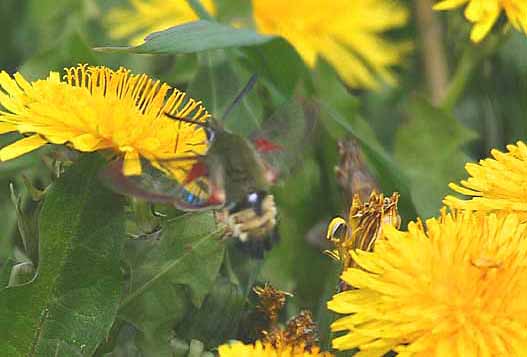Hemaris senta, [Strecker, 1878]
Rocky Mountain Clearwing Moth

Hemaris senta photo courtesy of Dona Hilkey,
Rio
Blanco County, Colorado at 7500 ft, May 23, 2004.
This site has been created by
Bill Oehlke at oehlkew@islandtelecom.com
Comments, suggestions and/or additional information are welcomed by Bill.
TAXONOMY:
Family: Sphingidae
Subfamily: Macroglossinae
Tribe: Dilophonotini
Genus: Hemaris (Dalman, 1816) ...........
Species: senta [Strecker, 1878]
|
MIDI MUSIC
.....It's a Wonderful World.....
copyright C. Odenkirk
ON.OFF
<bgsound src="world.mid" LOOP=FOREVER>
|
Those Sphingidae west of the continental divide, previously thought to be H. diffinis are now determined to be
the recently elevated species, Hemaris thetis. It is my understanding that the moths described as H. senta also belong to H. thetis as
thetis was described (Boisduval, 1855) before senta was described [Strecker, 1878].
Subsequently thetis was synonymized with diffinis, but, based on paper by Christian Schmidt
Journal of the Lepidopterists' Society 63(2), 2009, 100-109. Hemaris thetis (Boisduval, 1855) (Sphingidae), H. thetis in now recognized as a
distinct species, based on DNA and genitalia analysis.
In some places just East of the Divide (Colorado, Alberta) overlap of ranges of H. thetis and H. diffinis is known and precise determinations,
by photographs only, will be next to impossible.
Thanks to Edna Bottorff and Ryan St. Laurent for alerting me of this change. It will be a little while before I get the changes made on the Sphingidae of the Americas website.
I will shortly create the H. thetis page and will move all appropriate images off this page and add them to the new page.
DISTRIBUTION:
The California Clearwing or Rocky Mountain Clearwing Moth
(Wing span: 1 3/8 - 2 inches (3.5 - 5 cm)) flies in Colorado,
New Mexico, Montana, Idaho, Wyoming and Utah,
and west to California and north to British Columbia These moths are diurnal.
California clearwings have brownish-olive or olive-green heads and thoraxes. The abdomen, which has a
broad yellow band, is black or olive-green above and yellow below. Their wings have a very
narrow brown border and the clear parts of the wings have a steel-blue luster. The scaled areas of wings range
from dark brown to light brownish orange. Each wing has a large transparent
patch which covers most of the wing surface. The forewing cell lacks dark scales.
FLIGHT TIMES:
There is probably a single brood of this montane species from May-August.
The moth is seen along streamsides and in meadows in mountainous areas. Adult like to nectar from flowers
including kinnikinnick (Arctostaphylos uva-ursi) in the heath family, and lupines (Lupinus) in the
pea family.
ECLOSION:
Larvae pupate in thin walled cocoons under leaf litter.
SCENTING AND MATING:Females call in the males with a pheromone released from a gland at the tip of the abdomen.
EGGS, LARVAE, PUPAE:
Females feed and lay eggs on the underside of new leaves during the day.
Larval foods are probably snowberry (Symphoricarpos) species.
Pupation is in a very flimsy cocoon at ground surface.
The inch long pupa is brown.
Return to U. S. A. Table
Return to Sphingidae Index
Return to Dilophonotini Tribe
